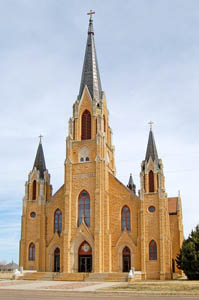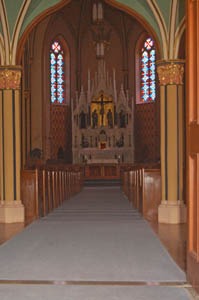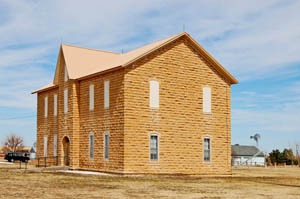Pfeifer, Kansas, is an unincorporated small town in southeast Ellis County.
Founded in August 1876 by immigrants originally from Pfeifer, Russia, the village was built on the south bank of the Smoky Hill River. Among the founders of the colony were some of the very first of the Germans to leave Russia, including Joseph Stremel, Michael Meder, Mathias Urban, and Christ Stegman. They originally left their homes in Russia in October 1875, and along the way were joined by other groups of Russian immigrants. Over the next two years, more settlers arrived in the fledgling village, and by 1878, the colony had approximately 41 families, comprising 171 people.
The original site chosen for the town had been railroad land and was to be paid for in 11 annual installments. It was divided into shares, and each resident paid a cost proportionate to the amount of land they held.
However, trouble soon arose when some landholders were unable to pay for their shares. Others, too, objected to the town’s location, so, finally, in 1884, the colony relocated northwest to its present site, which John Schlieter had acquired under the Homestead Act. He divided the land into shares, for which he provided a deed to the purchaser on receipt of the payment.
The residents immediately began to build simple homes and farm the area land. They built their first church, a small frame structure, in 1879. By 1887, the village had grown large enough to support a post office, which opened on March 15. In 1891, the residents built a new stone church to replace the simple frame building that had been previously used.
By 1910, Pfeifer had grown to about 150 people and sported a school and a couple of retail stores. Soon, plans were made for a bigger stone church, and construction began on the Holy Cross Church in April 1915. At the time, the church was known as “the two-cent church” because parish families paid two cents for each bushel of wheat they produced to fund construction. They also donated a significant amount of their time to building the church, including quarrying and delivering the stone.
The beautiful gothic-style church was completed in May 1918, at a cost of $56,000. A parochial school was also built to educate area students.
Unfortunately for the residents of the community, the decision was made by the Diocese of Salina to dissolve the parish, effective July 1, 1993. The church today no longer holds regular services, but remains open to the public on a daily basis and continues to be used for funerals, weddings, and other special events.
The Holy Cross Church in Pfeifer was voted as one of the Eight Wonders of Kansas Architecture because it is the finest example of a Gothic-style church in the state. A tour through the beautiful building features a rib-vaulted ceiling, decorative columns, and pointed-arch windows and doorways. The central spire is 165 feet high, believed to be the tallest Gothic church spire in the state of Kansas.
The nearby Holy Cross Cemetery has many interesting ornate Volga German iron crosses and is worth a visit.
Though Pfeifer’s population is very small today, its post office remains open. The tiny town is located about 10 miles south of Victoria.
©Kathy Alexander/Legends of Kansas, updated June 2025.
Also See:
Sources:
Blackmar, Frank W.; Kansas: A Cyclopedia of State History, Vol I; Standard Publishing Company, Chicago, IL 1912.
Cutler, William G; History of Kansas; A. T. Andreas, Chicago, IL, 1883.
German Capital of Kansas




